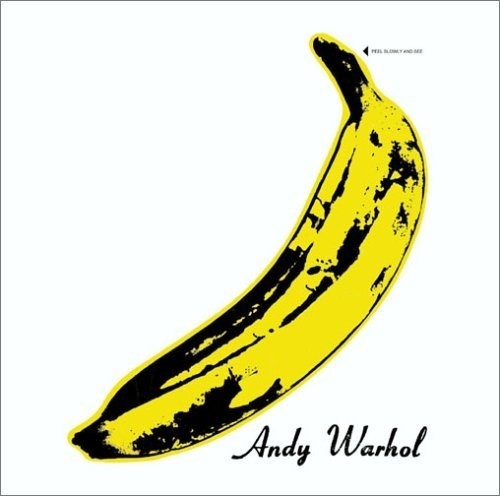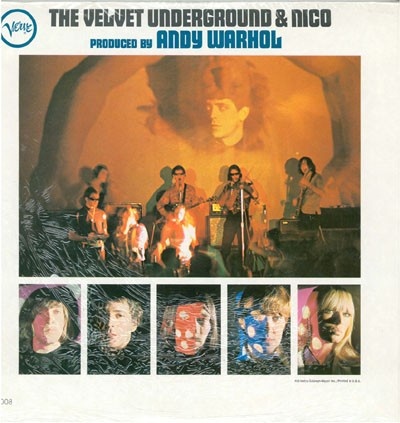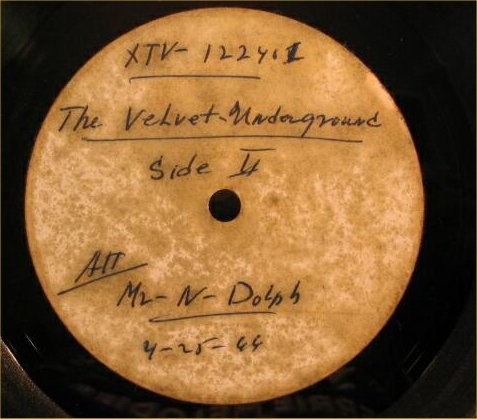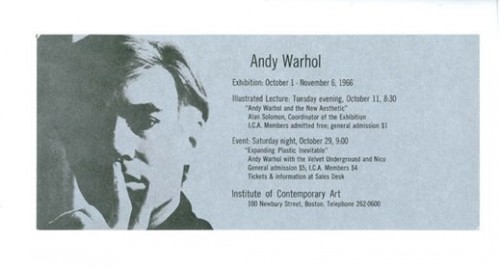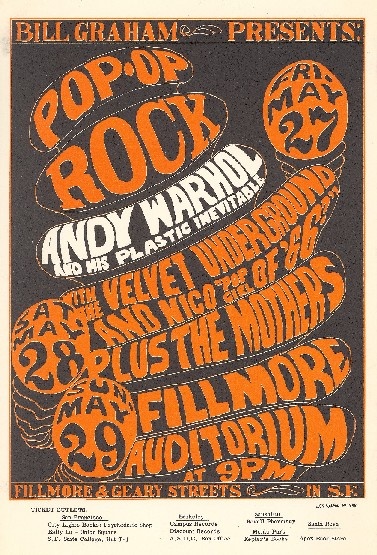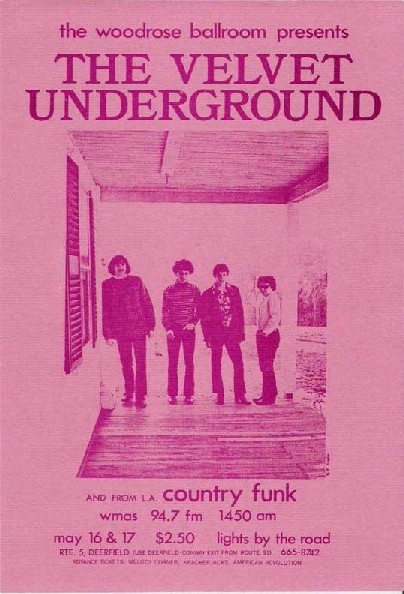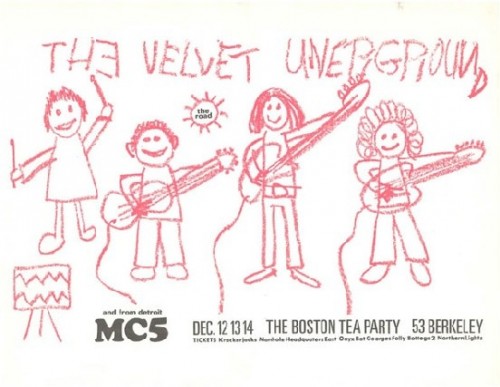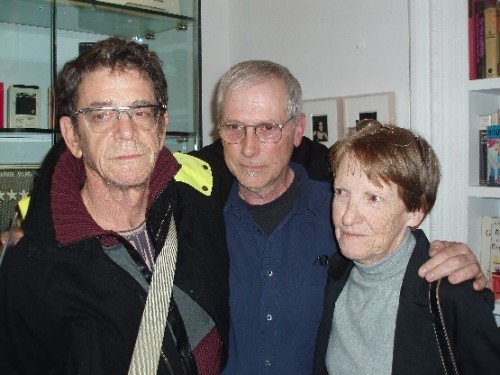The VU on View
A new exhibition in New York on The Velvet Underground
By: Steve Nelson - Apr 22, 2007
In early spring 1967, I stopped at the Harvard Cooperative Society to browse through their record bins. In those days almost everything at the Coop was classical, but it had some jazz and folk, and as a concession to the changing times so evident outside its doors in the Square, maybe 100 rock LPs in stock. One of them caught my eye. It was not the banana on the front cover, or even the name of Andy Warhol, but the images of the band on the back. They looked familiar. Could they be who I hoped they were? I had to find out, so I bought it, went back to my apartment, tore off the shrink wrap and put it on the turntable. Yes, it was them!
The previous spring my Harvard girlfriend (later the novelist Beth Gutcheon) got a pair of invites from a classmate (later the filmmaker James Toback) to a private party in New York. It was being thrown by George Plympton and The Paris Review at The Village Gate, and a lot of New York literati and celebs would be there. Who could resist? So we abandoned our books and hopped a train from Boston.
George himself was at the door greeting his friends and guests. Not being part of that New York scene, we soon gravitated to the lower level of the Gate, where a succession of rock groups played and we danced the night away. But the last band that came on at maybe two in the morning stood out from the rest, assaulting the ears and eyes with its music and lights, a primitive wail that never lost the beat. For me, dancing to rock 'n' roll could be a form of ecstatic release in which all thought gave way to oneness with the music, and that band took me higher than I'd ever been before. At one point through my reverie I saw a strange apparition, Frank Sinatra. He came down the stairs, stared in disbelief at the scene before him as though he had passed through the gates of hell, and quickly ascended back to the quieter conversation and cocktails above.
If the band was introduced that night, I missed it, and left without knowing who they were. But I couldn't forget that sound, and it wasn't until I played that record from the Coop that I knew at last whom I'd seen and heard: The Velvet Underground. It would be far from the last time that I did.
Few bands have had such a profound and lasting effect on music. In the Friday arts and leisure section in The New York Times just a few weeks ago, the Velvets were mentioned three times in pieces on contemporary bands. New York magazine recently named them the #1 musical artists ever from that city, topping names like Billie Holiday and Leonard Bernstein. But in 1967 that LP, The Velvet Underground and Nico, barely cracked the Billboard Top 200, and never getting a bullet on the charts, soon died.
Yet like the subject of the VU song "Jesus" in its third and self-titled album, the band has since been resurrected and glorified. And to mark the 40th anniversary of the release of the banana album, Johan Kugelberg has organized the most extensive exhibition ever of posters, artwork, photographs, recordings, original lyrics and other artifacts and ephemera related to the band. Entitled "c/o The Velvet Underground, New York, N.Y.", it is being presented by John McWhinnie @ Glenn Horowitz Bookseller at 50½ East 64th Street through May 12. The name of the exhibit was the title of a lengthy article about the band in the March 6, 1970 issue of Boston fanzine Fusion. The catalog for the show includes essays by, among others, sci-fi great William Gibson and Jonathan Richman, who was at almost all the Velvets' shows at The Boston Tea Party rock club in the late Sixties. He went on to front his Cambridge-based protopunk band The Modern Lovers, who gave The Cars their drummer David Robinson and Talking Heads their keyboardist Jerry Harrison.
The gallery specializes in manuscripts and first editions in art, photography, literature and design. That an exhibition on the VU could be on view in such a location in itself says that this was no everyday rock band. Of course, their association with Warhol helps, more so for the graphics he created for the band and his promotion of them than for his negligible involvement with their music. But Lou Reed's lyrics read like short stories about the mean streets of New York, and entitle him to that overused and usually undeserved appellation "rock poet."
Among the items on display in "c/o" is a 12" acetate (test recording) of an earlier unreleased version of the LP, unknown until found last year among a bunch of used records (including The Modern Lovers' first LP) in a street sale in Manhattan's Chelsea neighborhood. Purchased for 75 cents, it sold on eBay a few months ago for $26,000. While ostensibly about the 40th anniversary of the album's release, the show ranges far beyond that. We see relics and photos from early performances in New York at the Film-Maker's Cinematheque, Café Bizarre and The Dom. The first gig the band played as "The Velvet Underground" was at Summit High School in New Jersey in December 1965, opening for The Myddle Class, whose music and name were totally at odds with what the Velvets represented. In attendance was fifth grader Clint Conley, who tells me he remembers nothing of the performance. But like my experience at the Village Gate, something left a mark in Clint's psyche, as evident in his later work as bass player for Mission of Burma.
From the print promotion pieces in the exhibit we can follow the band on the road. There is the original artwork for the poster for a show in late summer 1966 at the Chrysler Art Museum in Provincetown, and two different invitations to an Andy Warhol exhibit that fall at Boston's Institute of Contemporary Art, where the VU played. Those were the days when they were part of Andy's Exploding Plastic Inevitable multimedia show, and on their first West Coast trip they played The Trip in L.A. (the poster reproduces a Newsweek cover with an exploding "Pop!" graphic) and the Fillmore Auditorium in San Francisco (where the poster ups the ante by billing them as "Pop-Op Rock"). Wes Wilson, who designed the Fillmore piece, was one of the San Francisco Five, the artists who created the psychedelic poster style associated with that city. The exhibit includes his original signed artwork for that May 1966 Fillmore gig. Maybe S.F. rock impresario Bill Graham, a voracious collector, didn't keep it because in fact he hated the Velvets. And fans of the Grateful Dead, Big Brother and Jefferson Airplane largely ignored them.
There is also a handbill for an appearance exactly a year later at The Boston Tea Party. I happen to own a copy of that handbill, which I picked up at that show. It was a souvenir of celebrating my 26th birthday, which meant I was no longer eligible to be drafted to serve in Vietnam. The next time I saw the Velvets at the Tea Party I had become, through a twist of fate and despite having no background in the music business, the manager of the club. During my stint there in '67-'68 and then in '69-'70 at a club I owned in western Massachusetts, the Woodrose Ballroom, I booked them many times. As a promoter I presented many great bands who deserved to be heard and, frankly, who could fill a room, but with the VU it was personal. I had no idea, of course, how important they would become, but they were special to me and I was committed to giving them a place to play, and money to do it, even if that meant taking them out of their urban milieu and bringing them to the Massachusetts countryside. One of the handbills in the show features a shot of the band on the front porch of my house in Conway, Mass. taken by Roswell Angier, later known for his photos of Boston's Combat Zone, home to hookers and honkytonks.
If you're not familiar with the band's history and you look at the many posters in the show, you might wonder where the later ones from New York are. Well, there aren't any, because for three years The Velvets didn't play there. They made their final N.Y. appearance with the EPI just before that May '67 show at the Tea Party, where they finally shed the EPI (and Nico) to become a straight-ahead rock band without the sideshow. They didn't play in New York again until their "last stand" at Max's Kansas City in the summer of 1970, at the end of which Lou left the band. So for three years the Tea Party became in effect their home club, and combined they played more gigs there and at the Woodrose than at any other venue during their career. David Swartz, the leading collector and archivist of Boston concert posters and memorabilia, was a major contributor to "c/o", and thanks to him the exhibition has a poster or handbill for every VU gig at the Tea Party. There is even a silkscreen for an imaginary Tea Party gig, a Boston dream bill with the Hallucinations, whose frontman Peter Wolf would later appear on the cover of Rolling Stone as lead singer for The J. Geils Band.
Moe Tucker, the Velvets' drummer, lent the exhibition a mockup of a proposed album cover made of cutouts of the band members from a December '68 Tea Party poster depicting them as though drawn by a kid (by this time founding band member John Cale had left the group and been replaced by Bostonian Doug Yule, who had played the Tea Party in a band called The Grass Menagerie). I was the "kid" who drew the poster, and when I showed it to Lou backstage he said, "How'd you know that's what we're really like?" Well, I knew them well enough to understand that behind the notorious image of the band (hard drugs, S&M, etc.) were four people who loved to play rock 'n' roll, and had a lot of fun doing it. One of the themes of "c/o" is to show how the band's image was handled, or mishandled, by various artists. In the kids poster I deliberately played against their image, and in so doing at the same time reminded people of it.
One thing you won't see if you visit the gallery was the extraordinary thing that happened at the April 12th opening of the exhibit, thanks to Johan. All three surviving members of the post-John Cale version of the band showed up, as did the widow of Sterling Morrison (to me one of the most underrated guitarists in rock history). It was the first time they were all together since Max's. The relationship between Lou and Doug has been strained since the latter led a post-Lou VU with Moe and Sterl, and then after Sterl left, a "Velvet Underground" with Moe and Boston's Willie Alexander and Walter Powers. To its discredit, when the Rock and Roll Hall of Fame inducted the Velvets, Doug was left out, despite playing on VU albums and songs included in the Hall's own best-ever lists. But in the gallery that night there was much picture-taking, tongue-wagging and jaw-dropping at the site of Lou, Doug and Moe hugging amidst the relics of their greatness.
Taking in that moment and the evening was Sal Mercuri, executive producer of recent VU compilation CDs. Thanks to Sal I've heard mastered live recordings of three Velvet shows at the Tea Party in late '68 and early '69. Some of this material has shown up before in bootleg form. But on these CDs, the power of the band live comes through like you won't hear on any other VU recording currently out there. They always sounded great in that room, playing to an audience who knew and loved them and their music. Unfortunately, the release of the CD set is on hold due to "complications" among the various parties involved and the record label. When and if it does become available, we'll have the only thing missing from the exhibit: hearing how the band really sounded. But then we'll have to call it "c/o The Velvet Underground, Boston, Mass."
Steve Nelson is president and co-founder of the new Music Museum Of New England. MM/ONE currently has a website at www.mmone.org and is presenting traveling exhibits and special events, such as its recent 40th anniversary commemoration of the Tea Party. Eventually it will operate a bricks-and-mortar visitors center and archive. The museum is hoping to instigate the release of the Tea Party CDs, and is seeking space in which to present the "c/o" exhibition in the Boston area, with added material reflecting the VU's relationship to New England. If you can provide such a space or help find it, please contact steve@mmone.org. For the exhibition contact www.johnmcwhinnie.com/currentexhibition/index.html.

